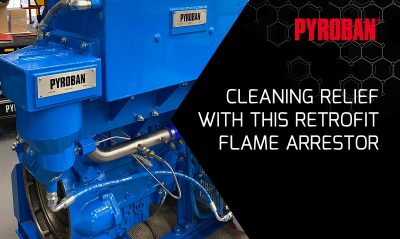For decades, “plate type” exhaust flame arrestors have been a key component on ATEX diesel engines that power temporary well service, production and pumping equipment offshore. There are however, 3 main reasons why the oil and gas industry want to move away from using them.
1. Time-consuming to clean every day
In most operating conditions “plate type” exhaust flame arrestors can clog up with soot very quickly. Typically, we see that they need to be cleaned every eight to twelve hours. This takes up valuable operator time, while also leading to non-productive downtime for the temporary well service equipment. Not to mention the extra solvents needed for cleaning offshore.
Don’t forget that exhaust flame arrestors are there to allow exhaust gases to pass through, but they will stop a flame leaving the exhaust system in the event of hydrocarbon gas ingestion. This is an important job in Zone 2 hazardous offshore areas, considering the risk of hydrocarbon release.
2. Manual handling compliance failure
Traditional plate type exhaust flame arrestors typically weigh more than 25kg and usually will be located above waist height. This undoubtedly makes them difficult to handle.
With so much changing and cleaning required, this can lead to short cuts being taken or the arrestor being handled incorrectly. The result? A failure for your organisation in compliance with manual handling regulations and a risk to your operators. It can also be demotivating for them.
3. Dummy arrestors increase risk
With plate type flame arrestors, it is possible for a ‘dummy arrestor’ to be inserted. In a Zone 2 hazardous area, this exposes operations to potential sources of ignition, rendering the explosion proof certification invalid, while also putting people at serious safety risk.
What’s the solution?
To help overcome these three issues, Pyroban has developed two new technologies that can be fitted to new equipment and existing Pyroban explosion protected engines already operating offshore.
Ever Clear™ Exhaust Flame Arrestors
 Ever Clear™ Exhaust (ECE) Flame Arrestors are a direct replacement for plate type flame arrestors. These are bolted into the exhaust system between the turbo and gas cooler, on the hot side of the exhaust flow. They are low in cost, can easily be fitted in the field and are suited to smaller engines, although Pyroban has options for most turbo diesel engines above 100bhp.
Ever Clear™ Exhaust (ECE) Flame Arrestors are a direct replacement for plate type flame arrestors. These are bolted into the exhaust system between the turbo and gas cooler, on the hot side of the exhaust flow. They are low in cost, can easily be fitted in the field and are suited to smaller engines, although Pyroban has options for most turbo diesel engines above 100bhp.
For as little as half the annual cleaning costs of a plate type exhaust flame arrestor, operators can upgrade their existing assets with Ever Clear and eliminate the issues surrounding cleaning requirements, manual handling, and ‘dummy’ arrestors.
Pyroban Ex SCS™
As a more advanced alternative, Pyroban’s Ex SCS™ combines flame arrestor elimination, safety shutdown and diesel engine control and monitoring in one flexible package. The system brings an active approach to the overall safety system by introducing gas detection into the engine inlet tract at a certified position and also within the equipment DNV 2.7-1 enclosure.
Ex SCS™ quickly and reliably triggers a safety shutdown on detection of a flammable gas in the engine air inlet, diesel engine over speed, high exhaust gas and coolant temperatures, low oil pressure or if there is a manual emergency stop activation. It is also easy to incorporate into additional driven equipment controls such as pumps, generators, transmissions, or the well head platform’s DCS (distributed control system).
Pyroban ATEX engine solutions
Both solutions are the result of many years of development, extensive field trials and testing, and the completion of the EN1834-1:2000 non-flame transmission tests.
It’s time to get on with job, enjoy longer operation and reduce downtime. For engines with Pyroban kits and HazPaks™ all over the world, order now.

